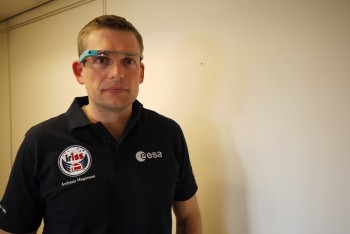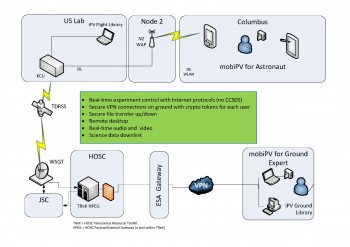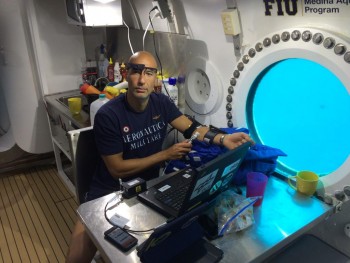
Andreas modeling the Google Glass mobiPV headset earlier this year. Credits: ESA–J. Harrod CC BY SA IGO 3.0
ESA’s Mikael Wolff and the team behind mobiPV passed an important milestone two weeks ago: the equipment that ESA astronaut Andreas Mogensen will test during his iriss spaceflight was shipped to Torino, Milan. From there the equipment consisting of two headsets (Google Glass and a headmounted WebCam) and two Nexus smartphones will travel to Baikonur, Kazachstan, en route to space in the same spacecraft Andreas will take to visit the International Space Station.
The importance of this shipment to Italy is that the software running mobiPV must now be “frozen”. To avoid any risks and unknown problems engineers may not update space software once the hardware is shipped without going through lengthy tests. Andreas’s launch is in just a few weeks’ time, not enough to implement changes to the software code.
mobiPV will test two improvements to how astronauts work on long and complex tasks. At the moment procedures can only be displayed on one of the Station laptops that must stay at their permanent location.
mobiPV aims to improve the mobility by allowing procedure steps to be seen and checked on a smartphone or tablet. Secondly, mobiPV hopes to test two-way video streaming between the astronaut and ground control.
Getting the data network set up is now priority for the team. mobiPV will be using a relatively new direct connection with ESA’s Columbus laboratory. “The network has been up and running and tested for other iriss experiments, but mobiPV is a tough customer” explains David Martinez-Oliveira, ESA’s lead engineer..
The mobiPV team are on-hand for the network specialists as end-user consultants. Commands, audio and video have a long way to travel. From Columbus the signals go to a wireless router in the Node2 module on the Station which are transferred to the Destiny laboratory via cable. From there they bounce via NASA’s TDRSS satellite to Houston, USA, and are transferred to ESA’s private network, travel across the Atlantic to arrive at the Columbus Control Centre in Oberpfaffenhofen, Germany, to finally be forwarded to the European Astronaut Centre in Cologne, Germany.
The team are testing the network with virtual machines in Huntsville and Houston that house replicas of the mobiPV experiment software.
If all goes well, Andreas will wear one of the two headsets during his mission in September and do a maintenance task on ESA’s biology facility Biolab using the mobiPV headset, smartphone and tablet. As he works he will be able to check the procedure and move to the next step without returning to a Station computer as well as having experts on Biolab at the astronaut centre “looking over his shoulder” to offer advice as needed.
Meanwhile Andreas’s colleague ESA astronaut Luca Parmitano is testing mobiPV underwater during NASA’s NEEMO training. He retweeted these images of himself wearing the mobiPV webcam and smartphone while running the Skin-B experiment that he had previously done in space. Andreas already used a version of mobiPV during his NEEMO mission.
Watch Andreas’s video below to see him explain the concept for the precursor project called HeadsUp with ESA astronaut Hervé Stevenin while underwater on NEEMO 19.





Discussion: one comment
Thank you, Andreas, for helping to educate the public with your videos. I have learned a lot and really enjoy them. Good luck!